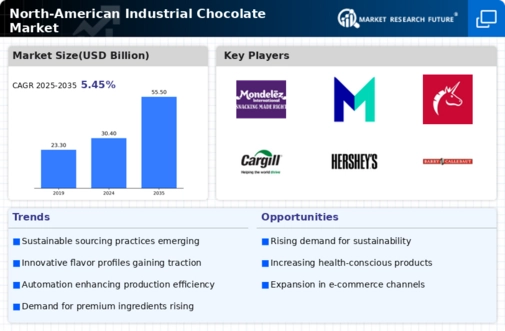Market Share
North American Industrial Chocolate Market Share Analysis
The North American industrial chocolate market is a dynamic landscape, characterized by intense competition and ever-evolving consumer preferences. Companies operating in this sector employ various market share positioning strategies to gain a competitive edge and establish a strong foothold in the industry. One prevalent approach is differentiation, where companies focus on creating unique and distinctive chocolate products that cater to specific consumer needs. This may involve incorporating exotic flavors, experimenting with premium ingredients, or offering specialized chocolate formulations, such as organic or sugar-free options. By standing out from the competition, companies aim to capture a niche market and build brand loyalty among consumers who seek distinct and high-quality chocolate experiences.
Another key strategy in market share positioning is cost leadership, where companies aim to become the low-cost producers in the industrial chocolate segment. Achieving economies of scale, optimizing production processes, and securing cost-effective raw materials are essential components of this approach. By offering competitively priced industrial chocolate without compromising on quality, companies can attract price-sensitive customers and secure a larger market share. This strategy often requires significant investments in technology, logistics, and supply chain management to streamline operations and reduce production costs.
Collaboration and strategic partnerships also play a pivotal role in market share positioning within the North American industrial chocolate sector. Companies may form alliances with suppliers, distributors, or even competitors to enhance their overall value chain. Collaborative efforts can lead to improved access to raw materials, expanded distribution networks, and shared research and development initiatives. By leveraging synergies with other players in the industry, companies can strengthen their market position and create a more formidable presence, allowing them to collectively address challenges and capitalize on emerging opportunities.
Innovation is a driving force in market share positioning strategies within the North American industrial chocolate market. Companies continuously invest in research and development to create new and innovative chocolate products that resonate with evolving consumer tastes. This may involve introducing novel flavors, textures, or formats that set a brand apart from its competitors. Additionally, advancements in processing technologies, such as improved tempering or conching methods, contribute to enhancing the quality and characteristics of industrial chocolate products. Through innovation, companies seek to capture the attention of consumers seeking cutting-edge and trendsetting chocolate offerings.
Furthermore, strategic marketing and branding initiatives are essential components of market share positioning in the North American industrial chocolate market. Companies invest in building strong brand identities, emphasizing the quality and values associated with their products. Effective marketing campaigns, digital presence, and engagement with consumers through social media platforms are crucial for creating brand awareness and loyalty. By establishing a positive and memorable brand image, companies can influence consumer perceptions, preferences, and purchasing decisions, ultimately translating into a larger market share.














Leave a Comment